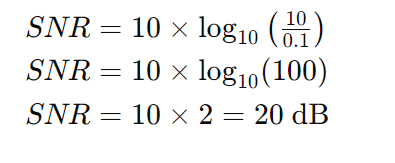SNR Signal To Noise Ratio Calculator
Introduction
Calculating the Signal-to-Noise Ratio (SNR) is crucial in various fields, including telecommunications, electronics, and audio engineering. SNR represents the ratio of signal power to noise power and is measured in decibels (dB). In this article, we’ll provide a comprehensive guide on how to use a SNR calculator effectively.
How to Use
To calculate SNR using our calculator, follow these simple steps:
- Enter the value of the signal power (in watts).
- Enter the value of the noise power (in watts).
- Click on the “Calculate” button to obtain the SNR result in decibels.
Formula
The formula to calculate SNR is:

Example Solve
Suppose we have a signal power of 10 watts and a noise power of 0.1 watts.

FAQ’s
Q: What is SNR?
A: SNR stands for Signal-to-Noise Ratio, representing the ratio of signal power to noise power.
Q: Why is SNR important?
A: SNR is crucial because it indicates the quality of a signal relative to the background noise, helping in the assessment of signal fidelity and reliability.
Q: What are the units of SNR?
A: SNR is typically measured in decibels (dB).
Q: How does SNR affect communication systems?
A: In communication systems, a higher SNR indicates better signal quality, leading to improved transmission reliability and data integrity.
Conclusion
In conclusion, understanding and calculating SNR are fundamental in various fields where signal quality assessment is critical. By using our SNR calculator, you can efficiently determine the quality of a signal relative to the background noise, aiding in optimal system performance.
